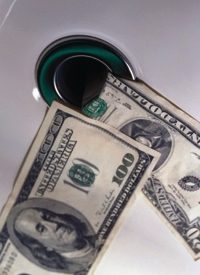
Another day, another government program mired in the traditional triumvirate of waste, fraud, and abuse. Today’s example: the Department of Energy’s Weatherization Assistance Program, funded with $5 billion in money from the American Recovery and Reinvestment Act of 2009 (a.k.a. the stimulus law).
Its purpose, says a recent Inspector Generals audit of Illinois portion of the program, is to improve the energy efficiency of single-family, multi-family, and mobile homes owned or occupied by individuals or families with low incomes. Illinois received a three-year grant of $242 million, which the state said it would use to weatherize about 27,000 homes. Of the $242 million, approximately $91 million went to the Community and Economic Development Association of Cook County, Inc. (CEDA), to weatherize 12,500 homes.
The Inspector Generals office had already issued a report in December 2009 raising concerns regarding inadequate monitoring and substandard contractor workmanship, according to the October 14 report, which is a follow-up to the December report, concentrating on CEDA, described as both the largest local agency of the Illinois Weatherization Program and one of the largest agencies nationwide participating in the Weatherization Program. Needless to say, the latest report finds little to no improvement in either the states or CEDAs performance.
Our testing, says the report, revealed substandard performance in weatherization workmanship, initial home assessments, and contractor billing. These problems were of such significance that they put the integrity of the entire Program at risk. Of the 15 homes they visited, twelve homes failed final inspection because of substandard workmanship; eight homes had initial assessments that called for inappropriate weatherization measures or the assessments overlooked key measures needed to make the homes more energy efficient; and for 10 homes, contractors billed for labor charges that had not been incurred and for materials that had not been installed, with billing issues described as pervasive.
The report notes that while CEDA inspectors conducted thorough inspections under the watchful eye of Energy Department auditors, past performance indicated a 62 percent final inspection error rate on those homes that the state re-inspected after CEDA had completed its initial inspections. Furthermore, CEDA had not followed up on corrective actions it required of poorly performing contractors, and the state had yet to conduct a one-week contractor certification class.
In all, 14 of the 15 homes the auditors visited failed final inspection because of poor workmanship and/or inadequate initial assessments. These were not merely cosmetic issues or things that could simply have been overlooked; many of them could have created safety risks. The report cites several examples:
In one home, 11 of the 14 items that the contractor should have installed or repaired to improve energy efficiency failed inspection. In another instance, while accompanying inspectors, we found that a contractor had not corrected, as required by the homes work order, improperly installed kitchen exhaust ductwork, a potential fire hazard…. Further, we observed a furnace intake vent pipe that had been improperly installed and found that five of the six tune-ups to heating systems had not been properly performed, allowing the heating systems to either improperly fire or emit carbon monoxide at higher than acceptable levels. Further, CEDAs own inspectors cited contractors for improper insulation of attics, band joists, and walls.
These findings, said the auditors, were consistent with state reports mentioning everything from the lack of shutoff valves on gas stoves to missing heat barriers around chimneys to nonexistent carbon monoxide detectors, smoke alarms, and fire extinguishers even a significant number of gas leaks.
The report concludes that while the State has taken a number of actions designed to correct previously observed weaknesses, lingering and significant problems remain. It recommends further actions by the Department of Energy, the state of Illinois, and CEDA to address the problems detailed in the report.
While the recommendations may improve the situation to some degree, the incentives that caused the problems in the first place will remain, making complete reform impossible. The biggest culprit, of course, is that the federal and state governments and CEDA are spending other peoples money and therefore have very little incentive to ensure that the money is spent wisely. Contractors, in turn, have every incentive to do shoddy work and to overbill for their work, knowing that the CEDA inspection and accounting regimes are lax and that those who will be living in the houses they are supposedly weatherizing also have little incentive, and even less ability, to ensure that the contractors are performing good workmanship.
The situation is the same with every government program the very reason the phrase waste, fraud, and abuse trips off the tongue so readily. As a matter of fact, Sen. Charles Grassley used that very phrase in a letter to Energy Secretary Steven Chu concerning the weatherization program, as the Washington Examiner‘s Byron York reports.
The entire stimulus law is both unconstitutional and rife with corruption. No amount of reform can fully correct either of these problems. The law should be repealed, and the programs receiving funding through it, shuttered. Doing so would be a good first step toward weatherizing the United States against the deluge of debt issuing from the worlds capital of waste, fraud, and abuse, Washington, D.C.



